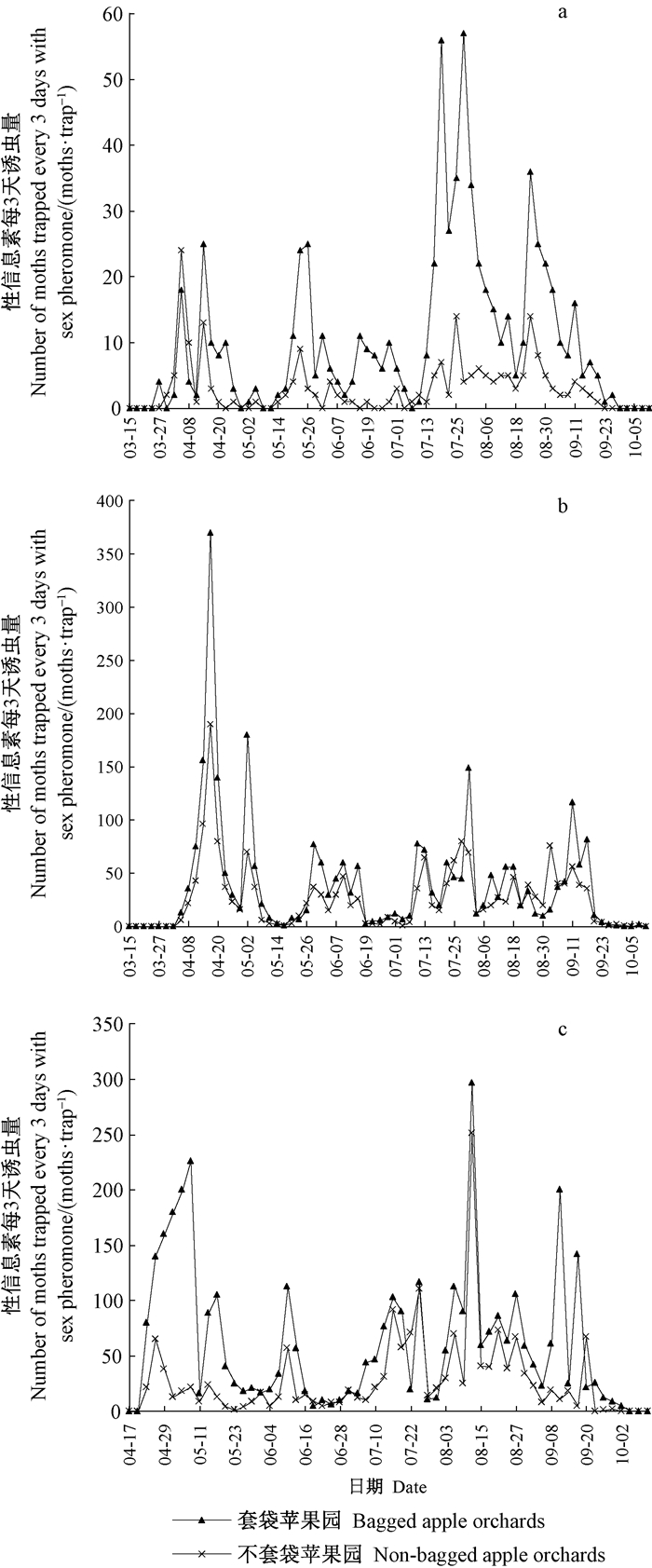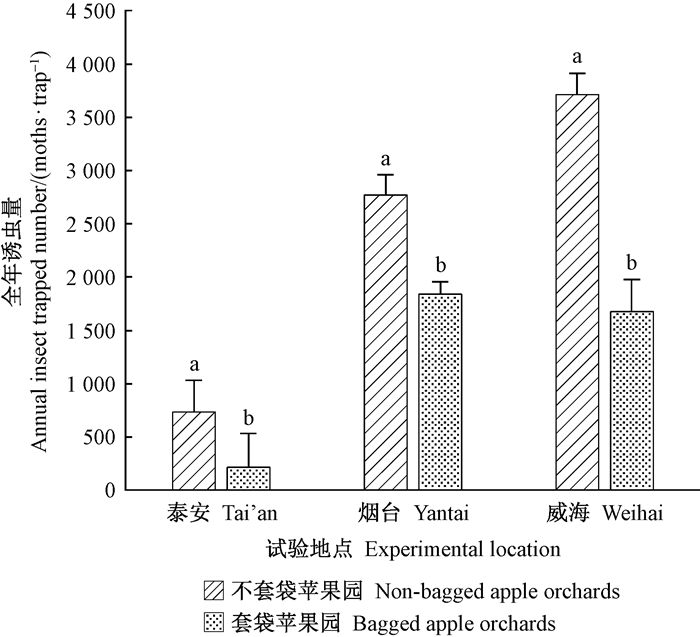文章信息
- 翟浩, 王金政, 薛晓敏, 王来平, 陈汝, 聂佩显, 张勇.
- Zhai Hao, Wang Jinzheng, Xue Xiaomin, Wang Laiping, Chen Ru, Nie Peixian, Zhang Yong.
- 苹果不套袋栽培模式下梨小食心虫(鳞翅目:卷蛾科)发生动态及性迷向素的防治效果
- Population Dynamics of Grapholitha molesta(Lepidoptera: Tortrididae) and Control Effects by Sexual Pheromone in Apple Orchards with Non-Bagged-Fruit Cultivation Pattern
- 林业科学, 2019, 55(7): 111-118.
- Scientia Silvae Sinicae, 2019, 55(7): 111-118.
- DOI: 10.11707/j.1001-7488.20190712
-
文章历史
- 收稿日期:2017-12-25
- 修回日期:2018-06-14
-
作者相关文章
梨小食心虫(Grapholitha molesta)属鳞翅目(Lepidoptera)卷蛾科(Tortricidae),分布在我国大部分果树产区,可危害桃(Prunus persica)、苹果(Malus pumila)、梨(Pyrus pyrifolia)、李(Prunus salicina)和樱桃(Prunus pseudocerasus)等多种果树的新梢和果实(Lu et al., 2012;Piskorski et al., 2011)。梨小食心虫具有典型的季节性转移寄主危害习性,在我国春季和夏初主要为害桃树新梢,夏末和秋季转移至苹果园、梨园危害果实,这一习性导致了果树梨小食心虫常年猖獗成灾(Najar-Rodriguez et al., 2013;Hern et al., 1999)。果实套袋是防治梨小食心虫主要措施之一,但由于我国生产果袋消耗纸张过多、劳动力紧缺及成本上涨、套袋苹果苦痘病重等问题,苹果栽培由套袋向免套袋转变将成为果树生产的必然趋势(翟浩等,2017;冯健等,2012)。苹果不套袋栽培模式下,由于缺少果袋的隔离保护作用,果实更易受到梨小食心虫的危害。此外,由于梨小食心虫一年发生多代贯穿苹果整个生长季节及其钻蛀为害的习性(Notter-Hausmann et al., 2010),仅靠表面施药达不到理想效果,且大量施药易造成环境污染、农残超标、天敌损失、害虫抗药性等问题(Stelinski et al., 2008;Damos et al., 2015)。除化学防控外,国内外主要应用性信息素对梨小食心虫进行诱捕和迷向防控,其中应用性迷向素防控梨小食心虫对控制下一代虫口数量及整体防控有明显优势(翟浩等,2018b;何超等,2008)。性信息素防控梨小食心虫主要通过诱捕雄成虫或干扰雄虫定位雌虫的能力(Witzgall et al., 2010)对梨小食心虫进行发生监测、诱杀(Cork et al., 2005;El-Sayed et al., 2006;陈汉杰等,1998a;1998b)和交配干扰(Brunner et al., 2002;李晓军等,2009;冯明祥等,2002)等,具有操作简单、高效专一、经济无毒、不伤天敌、不易产生抗性、不污染环境等优点(Stelinski et al., 2007)。
影响性信息素迷向效果的因素包含风向、风速和温度等环境因素(Ellis, 2006;Reinke et al., 2007;Foster et al., 1995;Kovanci et al., 2006),以及害虫迁移能力、虫口基数与密度间距等非环境因素(Ahmad, 1987;Foster et al., 1995;Rothschild et al., 1977;Kong et al., 2014)。目前,关于性信息素迷向防控梨小食心虫的研究多集中于桃园和梨园中梨小食心虫的防控以及性信息素迷向剂的剂型、施放技术和施放密度等方面(Il'ichev et al., 2004;Kovanci et al., 2009;Delwiche et al., 1998),对于不套袋栽培苹果园中梨小食心虫的发生动态、群体数量以及性信息素迷向防治效果鲜有报道。笔者于2017年在采用不套袋栽培模式的苹果园开展了梨小食心虫发生动态监测以及在梨小食心虫越冬代、第1代和第2代成虫羽化前期施放性信息迷向素防治梨小食心虫的试验,研究梨小食心虫的发生动态规律以及性信息素的迷向防治效果,探讨了性信息素迷向防控梨小食心虫的技术可行性及绿色防控的可靠性,以期为不套袋苹果园中梨小食心虫的精准防控提供试验依据。
1 材料与方法 1.1 试验材料供试果园为泰安市山东省果树研究所天平湖基地、威海市文登区明麦家庭农场、烟台市琅琊岭小龙农业农民专业合作社共3个富士(烟富3)苹果园。其中,天平湖基地试验苹果园中不套袋和套袋栽培面积各为1.0 hm2,树龄8年;明麦家庭农场试验苹果园中不套袋和套袋栽培面积各为2.0 hm2,树龄19年;小龙农业农民专业合作社试验苹果园中不套袋和套袋栽培面积各为6.0 hm2,树龄11年。套袋和不套袋栽培试验苹果园相隔100 m以上,不套袋栽培苹果园为第3年不套袋。
梨小食心虫性信息素诱芯由中国科学院动物研究所生产,每枚诱芯含性信息素200 μg。自制水盆型诱捕器,高18 cm,内口径为28~30 cm,盆中央悬挂性诱芯,距离水面1.0~2.0 cm,诱捕器中的液体使用洗洁精和自来水按体积混配(洗洁精:自来水=1:50)(翟浩等,2018a)。每条240 mg梨小食心虫性迷向素由深圳百乐宝生物农业科技有限公司生产,为可塑条迷向丝,长20 cm,内含细铁丝芯,外面包裹含有梨小食心虫性信息素的红色缓释胶层。35%氯虫苯甲酰胺水分散粒剂由美国富美实公司生产。
1.2 试验方法 1.2.1 梨小食心虫成虫群体动态监测2017年采用水盆型诱捕器诱捕法(杜家纬,1988;盛承发,2012),在越冬代成虫羽化前悬挂诱捕器监测梨小食心虫群体动态,其中:烟台、泰安统一于3月14日悬挂诱捕器,3月15日开始调查;威海于4月16日悬挂诱捕器,4月17日开始调查。诱捕器悬挂于苹果树树体2/3高度的外缘树枝处,东、南、西、北4个方位各放置1个,各诱捕器间相距50 m以上(翟浩等,2018b)。每3天调查1次各诱捕器的诱虫数量。
1.2.2 梨小食心虫蛀果率调查10-8―10-10,在3个地区的试验苹果园中分别调查套袋和不套袋果园中的蛀果率,每个果园共调查4个小区,每小区随机选择2株果树,每株树按东、西、南、北、中(内膛)5个方位随机调查20个果,共计200个果(翟浩等,2018a)。
1.2.3 性迷向素防治梨小食心虫试验在烟台市莱州琅琊岭不套袋苹果园中进行,共设5个处理:于越冬代、第1代和第2代成虫羽化前施放性迷向素+常规药剂(35%氯虫苯甲酰胺水分散粒剂)3个处理试验区,使用常规药剂(35%氯虫苯甲酰胺水分散粒剂)为阳性对照试验区,每个试验处理面积约1 hm2;在阳性对照处理区,随机选择4个小区,每小区2株树,不使用常规药剂,作为空白对照(翟浩等,2018b)。
性迷向素施放处理区:根据2017年梨小食心虫动态监测结果,2017年3月下旬(越冬代成虫羽化前)在处理1区施放性迷向素;在越冬代成虫羽化期,当连续2次诱捕到的成虫数量呈个位数时(第1代成虫羽化前),在处理2区施放性迷向素;在第1代成虫羽化期,当连续2次诱捕到的成虫数量呈个位数时(第2代成虫羽化前),在处理3区施放性迷向素。在这3个施放时期,3个处理区均按每地块495根·hm-2均匀施放,将每条240 mg梨小食心虫性迷向素均匀悬挂在树体离地2/3处,每个处理均一次性施放完毕;每个迷向区外围均采用495根·hm-2的剂量加倍密度处理2圈,以降低外围环境对试验区的影响(翟浩等,2018b)。
阳性对照处理区(单独使用常规化学防治试验区):以常规药剂防治为阳性对照,在每代梨小食心虫成虫高峰期,喷1次35%氯虫苯甲酰胺水分散粒剂(50 mg·L-1),10天后再喷1次。
1.2.4 性迷向素施放区梨小食心虫的动态监测及蛀果率调查在烟台市莱州琅琊岭不套袋果园,于2017年3月25日越冬代成虫羽化前,在每个处理区东、南、西、北、中5个方位,每个方位间隔50 m悬挂5个监测诱捕器,每3天调查1次诱蛾情况,及时更换性诱芯及配套诱捕器。
在第2代成虫羽化前施放性迷向素后,对各个处理区进行蛀果率调查,在每个处理区东、南、西、北4个方位,选择4个小区,每个小区2株果树,在树体的东、南、西、北、中(内膛)5个方位各标记20个无虫果实,共标记200个果实,每3天调查1次为害的蛀孔,进行标记,下次调查不再计数。
1.3 防治效果计算方法迷向率及防治效果分别按以下公式计算:
| $ 蛀果率(\%)=(虫果数/总果数)×100;$ | (1) |
| $ 迷向率(\%)=[(空白对照区诱蛾量-药剂处理区诱蛾量)/空白对照区诱蛾量]×100;$ | (2) |
| $ 蛀果防治效果(\%)=[(空白对照区蛀果率-药剂处理区蛀果率)/空白对照区蛀果率]×100。$ | (3) |
采用Excel 2010与数据处理软件DPS 16.05进行数据处理。利用方差分析和显著性检验(Duncan新复极差法),分析套袋和不套袋栽培苹果园中梨小食心虫蛀果率差异、性迷向素对梨小食心虫的田间迷向效果和防治效果,试验结果为平均值(mean)±标准差(SD)。
2 结果与分析 2.1 苹果套袋和不套袋栽培模式下梨小食心虫成虫发生动态监测泰安、烟台和威海试验区成虫发生动态如图 1a、b、c所示。2017年泰安地区成虫始发期和终见期分别为3月下旬和10月上旬,而烟台和威海地区分别为4月上旬和10月上旬。3个地区果园中,7―9月是梨小食心虫成虫群体数量发生高峰期,田间共出现5个比较明显的高峰,从第2个羽化高峰开始虫态交错,出现世代重叠。泰安地区梨小食心虫发生动态趋势和持续时间与烟台、威海2个地区差异比较明显,其中泰安地区梨小食心虫成虫于3月下旬开始羽化,发生高峰时期较集中,为7月上旬―9月下旬,而烟台和威海地区成虫均于4月上旬开始羽化,发生高峰时期较分散,在4月中旬出现1个越冬代羽化高峰后,在7月上旬―9月下旬再次出现羽化高峰。

|
图 1 2017年泰安(a)、烟台(b)和威海(c)苹果园梨小食心虫雄成虫发生动态 Fig. 1 The population dynamics of male adults of G. molesta in apple orchard of Tai'an(a), Yantai(b) and Weihai(c) in 2017 不同小写字母表示5%水平上差异显著 Different lowercase letters indicate significant difference at 0.05 level. |
3个地区套袋和不套袋苹果园中梨小食心虫成虫的发生动态趋势、羽化高峰期及持续时间差异不明显。从发生量上看,3个地区不套袋苹果园性信息素诱捕器的全年诱捕数量为每诱芯213~1 837头,显著低于套袋苹果园(每诱芯729~3 715头)(图 2)。

|
图 2 2017年山东苹果产区不套袋和套袋苹果园梨小食心虫雄成虫诱捕量 Fig. 2 The amount of male adults of G. molesta in apple orchards of Shandong Province in 2016 |
2017年泰安、威海、烟台3个地区不套袋苹果园中受害果实数和蛀果率显著高于套袋苹果园,其中,不套袋苹果园蛀果率为3.38%~6.13%,而套袋苹果园为0.13%~0.50%(表 1)。
|
|
2017年,烟台不套袋苹果园中,性迷向素在梨小食心虫越冬代、第1代和第2代成虫羽化期前的施放时间分别为3月30日、5月11日和6月22日。施放后,诱捕器诱捕数量骤降,均显著低于对照处理区(表 2)。在第2~4代成虫发生期,不同时期施放的性迷向素对雄成虫交配行为的干扰效果差异显著。对于第2代成虫,性迷向素的迷向率在不同时期施放处理间差异不显著;对于第3代成虫,在第1代和第2代成虫羽化前施放的2个处理,迷向率分别为99.45%和99.25%,均显著高于越冬代成虫羽化前的处理(93.82%);对于第4代成虫,迷向率在3个时期施放的处理间均差异显著,在第2代成虫羽化前施放效果最好。总之,性迷向素施放后对梨小食心虫雄成虫交配行为具有显著的干扰效果,不同时期施放处理间差异显著。
|
|
因梨小食心虫第1、2代幼虫很少危害苹果果实,故本研究只调查了对第3、4、5代幼虫的防治效果。性迷向素结合常规药剂处理的防治效果显著高于单独使用常规药剂处理和空白对照处理,单独使用常规药剂处理的防治效果显著高于空白对照处理(表 3)。性迷向素结合常规药剂处理对梨小食心虫的危害表现出较高的防治效果,在第3、4代幼虫危害盛期(07-19—08-06和08-12—09-05),不同时期施放的防治效果在90.18%~96.28%之间,且差异不显著;第5代幼虫危害盛期(9月11日~10月8日),在第1代和第2代成虫羽化期前施放的防治效果分别为92.89%和95.53%,显著高于在越冬代羽化前施放的效果(81.77%);单独使用常规药剂防治处理的防治效果为64.73%~76.84%,均显著低于性迷向素+常规药剂防治的3个处理。总之,性迷向素与常规化学药剂混合使用对梨小食心虫危害果实的防治效果显著,施放时期对防治梨小食心虫危害果实起关键作用。
|
|
性信息素迷向防治时大量释放的人工合成性信息素可对雄蛾产生强烈的刺激性,在高浓度的人工性信息素环境下,雄蛾触角感受器产生适应性,对雌性激素失去反应,导致雌雄交配概率减少,达到降低昆虫种群数量的目的(Bartell,1982;Valeur et al., 1996)。性信息素迷向防治效果的高低与成虫的交配习性、雌雄比例以及虫口密度等密切相关。梨小食心虫雄成虫有多次交配的习性,即使田间少量存在的雄虫也可和田间雌蛾交配并繁衍大量后代(孔维娜,2014)。因此,在低虫口密度果园使用性信息素迷向防治梨小食心虫,其效果更为理想;而虫口密度较高时,通过化学农药压低虫口密度并结合迷向防治,效果更佳。
在我国春季和夏初,梨小食心虫主要为害桃树新梢,夏季和秋季转移至苹果园、梨园危害果实(Najar-Rodriguez et al., 2013)。2017年烟台、威海、泰安3个地区田间梨小食心虫成虫发生高峰期均为7—9月,可能与梨小食心虫这个典型的季节性转移寄主危害习性有关。同一地区同一果园不同栽培模式下,梨小食心虫发生动态趋势、成虫发蛾高峰期和持续时间差异不明显,说明同一个地区苹果园果实套袋和不套袋对梨小食心虫发生动态无显著影响。梨小食心虫在不套袋苹果园发生数量显著低于同一地区中的套袋苹果园,可能与套袋和不套袋果园中越冬基数的差异以及套袋苹果园中果袋密集造成树体透光性差形成郁闭环境有关(帅哲元等,2014)。梨小食心虫主要活动时间是傍晚时段进入暗期前的几个小时(Gentry et al., 1975;张国辉等,2012;赵志国等,2013),套袋果园的郁闭环境为梨小食心虫提供了合适的活动场所,导致梨小食心虫在套袋果园中的发生数量高于不套袋果园。不套袋栽培苹果园梨小食心虫的蛀果率显著高于套袋苹果园,说明梨小食心虫的蛀果危害与果实是否套袋有直接关系,不套袋苹果园中,果实裸露,有利于梨小食心虫的蛀果危害,而在套袋果园中,果袋能够隔离梨小食心虫的危害,降低果实的受害率(蛀果率)。
与化学防控相比,性信息素迷向防治梨小食心虫高效、无毒、无污染,但缺点是价格昂贵而成本高(周洪旭等,2011)。红富士苹果为晚熟品种,果实发育期较长(4月中旬—10月中下旬),为达到理想的防治效果,需增加迷向素剂量或者施用次数,从而增加了防治成本,选择适宜的性信息迷向素施放时期可有效降低性信息素田间防治成本。本研究表明,在梨小食心虫越冬代、第1代和第2代成虫羽化期前施放性信息迷向素对梨小食心虫雄成虫交配行为均具有显著的干扰效果,不同时期施放处理间差异显著。在第1代和第2代成虫羽化期前释放性信息迷向素,结合常规药剂(35%氯虫苯甲酰胺水分散粒剂)对梨小食心虫的防治效果最好,显著高于越冬代成虫羽化期前处理。这可能与性信息迷向素的持效期、苹果果实发育期以及梨小食心虫的危害习性有关。
性信息迷向素有迷向丝、迷向管、迷向膏等剂型(冯崇川等,2002;李晓龙等,2013),通过缓释方式长时间释放高剂量的人工合成雌性信息素,具有一定的持效期。持效期过后性信息迷向素是否继续释放雌性激素,或者其释放量不足以干扰雌雄交配时,是否会起到相反的效果即诱集作用,从而加重梨小食心虫的为害,有待于进一步的研究。另外,性信息迷向素的迷向管、迷向丝等剂型不易降解,当达到其持效期限后不如及时撤出而继续悬挂,这本身也是一种环境污染,也不利于枝条粉碎返田,造成土壤污染。因此有必要研究易降解或者易撤出的剂型,以达到真正的环保、无污染的效果。
4 结论泰安、威海、烟台3个地区苹果园中,梨小食心虫成虫田间始发期为3月中下旬至4月上旬,终见期均为10月上旬,期间共出现5次羽化高峰,7—9月为梨小食心虫成虫发生高峰期。不套袋苹果园中梨小食心虫成虫发生数量显著低于套袋苹果园,但幼虫蛀果数显著高于套袋苹果园。梨小食心虫成虫群体发生动态趋势、羽化高峰期和持续时间在套袋和不套袋2种栽培模式下差异不明显。在不套袋栽培苹果园中使用迷向素结合常规化学防治对梨小食心虫的防治效果显著高于单独常规化学防治,其中在梨小食心虫第1代和第2代成虫羽化前期施放性信息迷向素对梨小食心虫的防治效果最佳。
陈汉杰, 邱同铎, 张金勇. 1998a. 用性信息素加农药诱杀器防治梨小食心虫的田间试验. 昆虫知识, 35(5): 280-282. (Chen H J, Qiu T D, Zhang J Y. 1998a. Field experment of the attracticide trips for controlling Grapholitha molesta Busck. Entomological Knowledge, 35(5): 280-282. [in Chinese]) |
陈汉杰, 邱同铎. 1998b. 梨小食心虫性诱剂附加农药诱杀器的设计. 昆虫知识, 35(2): 108-110. (Chen H J, Qiu T D. 1998b. Design of trips for Grapholitha molesta Busck with sex pheromone and pesticides. EntomologicalKnowledge, 35(2): 108-110. [in Chinese]) |
杜家纬. 1988. 昆虫信息素及其应用. 北京: 中国林业出版. (Du J W. 1988. Insect pheromone and its application. Beijing: China Forestry Press. [in Chinese]) |
冯崇川, 韩明玉, 杜志辉, 等. 2002. 引进日本性信息素迷向丝控制苹果害虫试验初报. 西北农业学报, 11(3): 76-77. (Feng C C, Han M Y, Du Z H, et al. 2002. Preliminary report in experiment controlled apple pests by sex pheromones from Japan. Acta Agriculturae Boreali-Occidentalis Sinica, 11(3): 76-77. DOI:10.3969/j.issn.1004-1389.2002.03.019 [in Chinese]) |
冯健, 张永茂, 程建新, 等. 2012. 套袋对陇东黄土高原富士苹果果皮特征及品质的影响. 西北农业学报, 21(12): 93-96. (Feng J, Zhang Y M, Cheng J X, et al. 2012. Influence of bagging on the characteristics of Fuji apple pericarp and quality in Longdong loess plateau. Acta Agriculturae Boreali-Occidentalis Sinica, 21(12): 93-96. DOI:10.7606/j.issn.1004-1389.2012.12.018 [in Chinese]) |
冯明祥, 姜瑞德, 王佩圣, 等. 2002. 用性外激素迷向法防治桃树梨小食心虫. 落叶果树, (5): 9-10. (Feng M X, Jiang R D, Wang P S, et al. 2002. Experiment of mating disruption control Grapholitha molesta Busck by using sex pheromone in peach orchard. Deciduous Fruits, (5): 9-10. DOI:10.3969/j.issn.1002-2910.2002.05.004 [in Chinese]) |
何超, 秦玉川, 周天仓, 等. 2008. 应用性信息素迷向法防治梨小食心虫试验初报. 西北农业学报, 17(5): 107-109. (He C, Qin Y C, Zhou T C, et al. 2008. Experiment of mating disruption control Grapholitha molesta Busck by using sex pheromone. Acta Agriculturae Boreali-Occidentalis Sinica, 17(5): 107-109. DOI:10.3969/j.issn.1004-1389.2008.05.024 [in Chinese]) |
孔维娜. 2014.基于交配行为的梨小食心虫干扰机制与诱源筛选研究.太谷: 山西农业大学博士学位论文. (Kong W N. 2014. Research on mechanism of disrupting mate and selection of attractive sources based on mating behaviors in Grapholita molesta (Busck). Taigu: PhD thesis of Shanxi Agricultural University.[in Chinese]) http://cdmd.cnki.com.cn/Article/CDMD-10113-1015623650.htm |
李晓军, 张勇, 王涛, 等. 2009. 0.24 g·条-1梨小食心虫信息素缓释剂防治桃树梨小食心虫试验. 农药, 48(5): 374-375. (Li X J, Zhang Y, Wang T, et al. 2009. The field trial of the pheromone 0.24 g·bar-1 BR on controlling Grapholitha molesta. Agrochemicals, 48(5): 374-375. DOI:10.3969/j.issn.1006-0413.2009.05.022 [in Chinese]) |
李晓龙, 夏国宁, 何建川, 等. 2013. 复合式膏体迷向剂对梨小、桃小食心虫的防控效果. 植物保护, 39(6): 147-152. (Li X L, Xia G N, He J C, et al. 2013. Control effects of a dual sex pheromone cream on the oriental fruit moth and peach fruit moth in apple orchards. Plant Protection, 39(6): 147-152. DOI:10.3969/j.issn.0529-1542.2013.06.028 [in Chinese]) |
盛承发. 2012. 性诱剂在害虫绿色防控中的应用. 高科技与产业化, 8(3): 59-61. (Sheng C F. 2012. The application of sexual pheromone trap in pest green control. High-Technology & Industrialization, 8(3): 59-61. [in Chinese]) |
帅哲元, 李峰. 2014. 套袋苹果的优缺点分析. 农业科技与信息, (24): 13, 18. (Shuai Z Y, Li F. 2014. The analysis of advantages and disadvantages of bagged apple. Agricultural Science, Technology and Information, (24): 13, 18. [in Chinese]) |
张国辉, 仵均祥. 2012. 梨小食心虫成虫行为节律研究. 西北农林科技大学学报:自然科学版, 40(12): 131-135. (Zhang G H, Chu J X. 2012. Behavioral rhythms of the oriental fruit moth, Grapholita molesta (Busck) (Lepidoptera:Tortricidae). Journal of Northwest A&F University:Nat Sci Ed, 40(12): 131-135. [in Chinese]) |
翟浩, 陈汝, 薛晓敏, 等. 2017. 信息素迷向法防治不套袋苹果园的梨小食心虫. 落叶果树, 49(1): 35-36. (Zhai H, Chen R, Xue X M, et al. 2017. The control of Grapholitha molesta Busck with sexual pheromone trapin no-bagged cultivation apple orchard. Deciduous Fruits, 49(1): 35-36. [in Chinese]) |
翟浩, 王金政, 王贵平, 等. 2018a. 苹果不套袋栽培模式下桃小食心虫发生动态及性信息素诱杀防治效果. 核农学报, 32(3): 617-623. (Zhai H, Wang J Z, Wang G P, et al. 2018a. Population dynamics of Carposina sasakii Matsumura and control effects of sexual pheromone trap in the cultivation pattern without bagged. Journal of Nuclear Agricultural Sciences, 32(3): 617-623. [in Chinese]) |
翟浩, 张勇, 李晓军, 等. 2018b. 性迷向素胶条结合化学药剂规模化防控晚熟梨园梨小食心虫. 果树学报, 35(增): 148-154. (Zhai H, Zhang Y, Li X J, et al. 2018b. Scale control over Grapholitha molesta Busck with mating disruption clip combined with chemical control in late-ripening pear orchard. Journal of Fruit Sciences, 35(Suppl.): 148-154. [in Chinese]) |
周洪旭, 李丽莉, 于毅. 2011. 信息素迷向法规模化防治梨小食心虫. 植物保护学报, 38(5): 385-389. (Zhou H X, Li L L, Yu Y. 2011. Scale control over Grapholitha molesta with mating disruption of sex pheromone. Acta Phytophylacica Sinica, 38(5): 385-389. [in Chinese]) |
赵志国, 高丽华, 杨慧娟, 等. 2013. 梨小食心虫性诱芯监测成虫交配时辰节律研究. 山西农业科学, 41(4): 366-368. (Zhao Z G, Gao L H, Yang H J, et al. 2013. Research on mating timing rhythm of oriental fruit moth monitored by sex pheromone lure. Journal of Shanxi Agricultural Sciences, 41(4): 366-368. DOI:10.3969/j.issn.1002-2481.2013.04.18 [in Chinese]) |
Ahmad T R. 1987. Effects of pheromone trap design and placement on capture of almond moth, Cadra cautella (Lepidoptera:Pyralidae). Journal of Economic Entomology, 80(4): 897-900. DOI:10.1093/jee/80.4.897 |
Bartell R I. 1982. Mechanisms of communication disruption by pheromone in the control of Lepidoptera:a review. Physiological Entomology, 7: 353-364. DOI:10.1111/j.1365-3032.1982.tb00310.x |
Brunner J, Welter S, Calkins C, et al. 2002. Mating disruption of codling moth:a perspective from the Western United States. IOBC Wprs Bulletin, 25(9): 11-19. |
Cork A, Alam S N, Rouf F M, et al. 2005. Development of mass trapping technique for control of brinjal shoot and fruit borer, Leucinodes orbonalis (Lepidoptera:Pyralidae). Bulletin of Entomological Research, 95(6): 589-596. DOI:10.1079/BER2005389 |
Damos P, Colomar L A, Ioriatti C. 2015. Integrated fruit production and pest management in Europe:the apple case study and how far we are from the original concept?. Insects, 6(3): 626-657. |
Delwiche M, Atterholt C, Rice R. 1998. Spray application of paraffinemulsions containing insect pheromones for mating disruption. Transactions of the ASAE, 41(2): 475-480. DOI:10.13031/2013.17163 |
Ellis N H. 2006. Flight phenology and dispersal of Grapholita Molesta (Busck) as affected by rubidium enrichment and orchard hosts. Pennsylvania: PhD thesis of The Pennsylvania State University.
|
El-Sayed A M, Suckling D M, Wearing C H, et al. 2006. Potential of mass trapping for long-term pest management and eradication of invasive species. Journal of Economic Entomology, 99(5): 1550-1564. DOI:10.1093/jee/99.5.1550 |
Foster S P, Ayers R H, Muggleston S J. 1995. Trapping and sex pheromone-mediated flight and landing behavior of male Ctenopseustis obliquana. Entomologia Experimentalis et Applicata, 74(2): 125-135. DOI:10.1111/j.1570-7458.1995.tb01884.x |
Gentry C R, Beroza M, Blythe J L. 1975. Pecan bud moth:captures in Georgia in traps baited with the pheromone of the oriental fruit moth. Environmental Entomology, 4(2): 227-231. DOI:10.1093/ee/4.2.227 |
Hern A, Dorn S. 1999. Sexual dimorphism in the olfactory orientation of adult Cydia pomonella in response to α-farnesene. Entomologia Experimentalis et Applicata, 92(1): 63-72. DOI:10.1046/j.1570-7458.1999.00525.x |
Il'ichev A L, Williams D G, Milner A D. 2004. Mating disruption barriers in pome fruit for improved control of oriental fruit moth Grapholita molesta Busck (Lep. , Tortricidae) in stone fruit under mating disruption. Journal of Applied Entomology, 128(2): 126-132. |
Kovanci O B, Gencer N S, Larsen T E. 2009. The deposition and retention of a microencapsulated oriental fruit moth pheromone applied asan ultra-low volume spray in the canopy of three peach cultivars. Bulletin of Insectology, 62(1): 69-74. |
Kovanci O B, Schal C, Walgenbach J F, et al. 2006. Effects of pheromone loading, dispenser age, and trap height on pheromone trap catches of the oriental fruit moth in apple orchards. Phytoparasitica, 34(3): 252-260. DOI:10.1007/BF02980952 |
Kong W N, Hu R S, Zhao Z G, et al. 2014. Effects of trap height, location, and spacing on pheromone-baited trap catch efficacy for oriental fruit moths (Lepidoptera:Tortricidae) in a peach orchard. Canadian Entomologist, 146(6): 684-692. DOI:10.4039/tce.2014.20 |
Lu P F, Huang L Q, Wang C Z. 2012. Identification and field evaluation of pear fruit volatiles attractive to the oriental fruit moth, Cydia moleata. Journal of Chemical Ecology, 38(8): 1003-1016. DOI:10.1007/s10886-012-0152-4 |
Najar-Rodriguez A, Orschel B, Dorn S. 2013. Season-long volatile emissions from peach and pear trees in situ, overlapping profiles, and olfactory attraction of an oligophagous fruit moth in the laboratory. Journal of Chemical Ecology, 39(3): 418-429. |
Notter-Hausmann C, Dorn S. 2010. Relationship between behavior and physiology in an invasive pest species:oviposition site selection and temperature-dependent development of the oriental fruit moth (Lepidoptera:Tortricidae). Environmental Entomology, 39(2): 561-569. DOI:10.1603/EN09231 |
Piskorski R, Ineichen S, Dorn S. 2011. Ability of the Oriental fruit moth Grapholita molesta (Lepidoptera:Tortricidae) to detoxify juglone, the main secondary metabolite of the non-host plant walnut. Journal of Chemical Ecology, 37(10): 1110-1116. DOI:10.1007/s10886-011-0015-4 |
Reinke M D, Barrett B A. 2007. Sublethal exposure to methoxyfenozide-treated surfaces reduces the attractiveness and responsiveness in adult oriental fruit moth (Lepidoptera:Tortricidae). Journal of Economic Entomology, 100(1): 72-78. DOI:10.1093/jee/100.1.72 |
Rothschild G H I, Minks A K. 1977. Some factors influencing the performance of pheromone traps for oriental fruit moth in Australia. Entomologia Experimentalis et Applicata, 22(2): 171-182. DOI:10.1111/j.1570-7458.1977.tb02704.x |
Stelinski L L, Miller J R, Ledebuhr R, et al. 2007. Season-long mating disruption of Grapholita molesta (Lepidoptera:Tortricidae) by one machine application of pheromone in wax drops (SPLAT-OFM). Journal of Pest Science, 80(2): 109-117. DOI:10.1007/s10340-007-0162-0 |
Stelinski L L, Miller J R, Rogers M E. 2008. Mating disruption of citrus leafminer mediated by a noncompetitive mechanism at a remarkably low pheromone release rate. Journal of Chemical Ecology, 34(8): 1107-1113. DOI:10.1007/s10886-008-9501-8 |
Valeur P G, Lofstedt C. 1996. Behaviour of male oriental fruit moth, Grapholita molesta, in overlapping sex pheromone plumes in a wind tunnel. Entomologia Experimentalis et Applicata, 79(1): 51-59. DOI:10.1111/j.1570-7458.1996.tb00808.x |
Witzgall P, Kirsch P, Cork A. 2010. Sex pheromones and their impact on pest management. Journal of Chemical Ecology, 36(1): 80-100. |
 2019, Vol. 55
2019, Vol. 55

